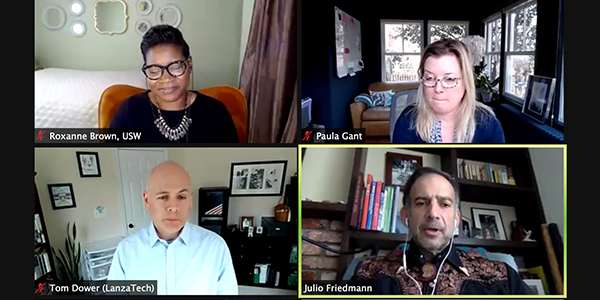Five countries that control about two-thirds of global iron and steel production must work together to reduce carbon emissions in the sector, according to researchers from Columbia University’s Center on Global Energy Policy (CGEP).
“China alone produced over 50% of the world’s steel last year and for the first time reached one gigaton (one million tons),” CGEP research associate Zhiyuan Fan said at a webinar Tuesday. Fan co-authored a new report on technology options, economic assessment and policy to achieve low-carbon production of iron and steel.
Global steel production totaled 1.9 million tons in 2020, with the top five producers being China, India, Japan, Russia and the U.S. The sector is responsible for 6% of global emissions.

CGEP Panel: Clockwise from top left: Roxanne Brown, United Steelworkers; Paula Gant, Gas Technology Institute; Julio Friedmann, CGEP; John Larsen, Rhodium Group; Zhiyuan Fan, CGEP; and Tom Dower, LanzaTech. | Center on Global Energy Policy
Fan’s co-author, CGEP senior research scholar Dr. Julio Friedmann, said there are relatively few technical options to manage the challenges of chemical reduction for iron ore refining and high-temperature heat sources required to power electric arc furnace (EAF) and blast furnace-basic oxygen furnace (BF-BOF) production.
“And all the options increase costs, which is why it might work best from a policy perspective to fence off two-thirds of global production,” Friedmann said.
Policy challenges include the globally traded nature of iron and steel, security and economic concerns at the national level, and the small margins of most producers and labor politics, the report said. Moreover, steel mills have long capital lives, limiting the rate and range of options to substitute for existing facilities and thereby reduce emissions.
The report suggested that policymakers identify opportunities for international cooperation on development of low-emission production standards for steel akin to the Montreal Protocol.
Unsticking Innovation
Innovation is the path forward for job creation and retention in all industrial sectors, “and sometimes these innovations get stuck on the policy pieces,” said Roxanne Brown, international vice president at large for the United Steelworkers. The union represents workers in many sectors and has been engaged for more than 15 years in efforts to mitigate carbon emissions from industrial processes, she said.
“We kept getting stuck at [the U.S. Environmental Protection Agency] around the renewable fuel standard,” she added, saying that it’s critical to work together to “unstick these innovations.”
Dr. Paula Gant, senior vice president for strategy and innovation at the Gas Technology Institute, said the institute is interested in the role that hydrogen is going to play in industrial decarbonization, but echoed Brown’s call for effective policy.
“It’s clear that we have dual imperatives of deep decarbonization across our economies, while also ensuring we have economic progress that is more broadly distributed,” Gant said. “We can’t do one or the other of those things; we have to do them both. … We have to change the paradigm that pits a living wage against economic competitiveness.”
According to the report, BF-BOF dominates production (71%) and is particularly stubborn to any decarbonization technology. DRI-EAF production is 5% of production and growing, but it appears to have better decarbonization potential to move toward net zero. Scrap steel in electric arc furnace is 24% of global production, consumes the least energy and is simplest to decarbonize through electrification, but is limited in market share, the report said. In addition, blue hydrogen, carbon neutral biomass and carbon capture and sequestration seem to have the lowest cost and highest technical maturity.
Tom Dower, vice president for public policy at carbon-recycling technology firm LanzaTech, said that addressing climate change requires “every possible solution.”
“We need to spur a fundamental change in how we do and make virtually everything that we have come to rely upon for modern society,” he said.
The report suggested that new policies should support the deliberate early retirement and replacement of current steel-producing facilities with low-emission options. Additional policy design is needed to help shift to scrap steel recycling using zero-carbon electric power, the report said. Other policy options that the report said could speed decarbonization in the sector include investment in low-carbon infrastructure and green procurements.
